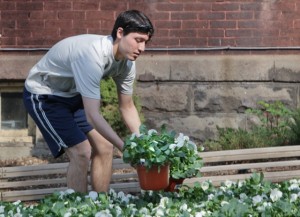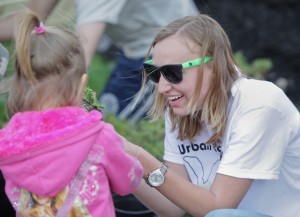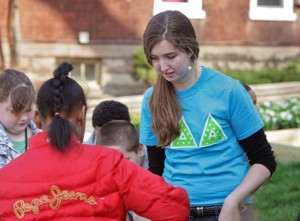
Andrew Chun '12 prepares flowers to be planted.
By Michele Tallarita ’12
The biggest flower in Easton sprung up in the most unlikely of places.
Nestled between brick houses and feet away from the passing cars of Northampton Street in the city’s West Ward, a 16-foot-long flower spreads its petals of white pansies while its yellow center stretches toward the sky.
The project is the work of Lafayette’s Technology Clinic, a group of students working to foster a sense of community in the West Ward through aesthetic improvement and economic investment. Inspired by the Art of Urban Environments Festival, the Tech Clinic worked with local children, businesses, and organizations to create the eye-grabbing urban bloom.
“We were trying to create a community event that would be grassroots and that would work with kids to bring art into their everyday vernacular,” says Hamish MacPhail ’13 (Bedford, Mass.), a government and law major. “We want to close the gap between the people who are interested in art and the kids whom we hope will be interested in art.”
The flower installation is part of an ongoing effort by the Tech Clinic to shed light in the West Ward. Past projects have included organizing community discussions about green living techniques, designing methods of water conservation, and cleaning up Raspberry Park.

Sam Griffith '13
Tech Clinic is a hands-on course that brings together students from different majors to help solve real-world problems of a business, nonprofit organization, or government body. The course lasts two semesters, and students are nominated by their professors. It’s directed by Larry Malinconico, associate professor of geology and environmental geosciences, and Dan Bauer, professor emeritus of anthropology and sociology.
Through the flower installation, the group sought to use art to get kids excited about their community. “It’s the idea of sweat equity, a sense of ‘I did that,’” says Andrew Chun ’12 (Monroe, N.Y.), a government and law major. “The project provides kids with a sense of ownership of their neighborhood. They used their own hands to make this piece.”
Toward the end of the spring semester, children from the Easton Area Community Center came to the site at Eighth and Northampton Streets to shovel mulch, pot the flowers, and arrange them into the shape of a 16-by-16-foot shad flower. It’s big enough to snatch the attention of passersby and to be seen as far away as the Easton Cemetery.
The flowers, compost, and mulch came from local businesses free of cost or at discounted rates, and the Easton Baking Company sent up dozens of pastries on planting day.

Anne Bond ’13 helps children with the flowers.
The Tech Clinic also worked closely with West Ward Neighborhood Partnership (WWNP) and received funding from a Wells Fargo Regional Foundation grant.
Esther Guzman, WWNP director, says the neighborhood received the flower installation with enthusiasm. “The people love the Shad flower, and the kids had a great, fantastic time. The kids got involved in planting, mulching, and checking out the worms,” she says. “When people look at art in the neighborhoods, I think it gives them a sense of pride.”
Tech Clinic chose the shad flower because it’s the symbol of the Art of Urban Environments Festival, which is sprinkling Easton’s streets, streams, and bridges this summer with 11 outdoor sculptures made by artists from across the country. It’s running parallel to the Fringe Festival, a 16-week block party every Saturday on 12th Street featuring food, live music, arts and crafts, and kids’ activities.
The flower is footsteps away from one of the Art of Urban Environments sculptures, Alan Marrero’s “Tributary Dreams.” It’s a glass mosaic that climbs the Eighth Street staircase in swirls of green, blue, orange, and yellow.
Though the flower isn’t technically part of the festival, neighbors and tourists who stop to see the stair mosaic will want to see it, too. The festival also supplied a banner for the site, on which the student artists traced their hands and signed their names.
The end result is the transformation of a littered, grassy area into a colorful work of art in which the community can take pride. “People who walk by can make the connection that kids from the neighborhood put this together,” says Chun.
Next semester, the Tech Clinic is looking to continue promoting art in the city by proposing a chalk festival, block party, and mural wall. Other members of this year’s team are Sam Griffith ’13 (Ocean City, N.J.), a history major; Szu-Ying “Sandy” Chen ’13 (Bangkok, Thailand); a chemical engineering major; and Anne Bond ’13 (Radnor, Pa.), an anthropology and sociology major.


